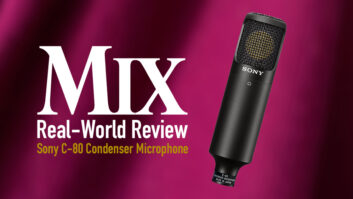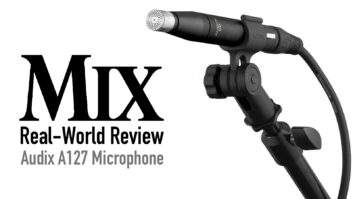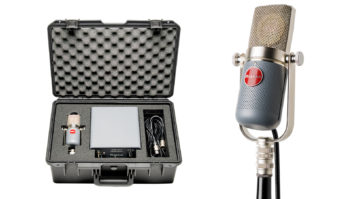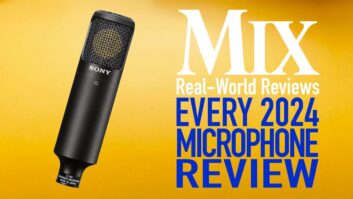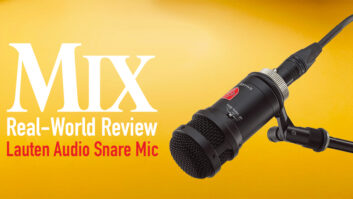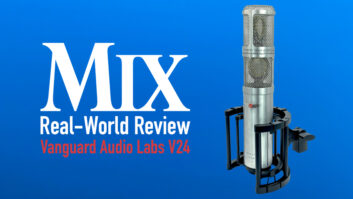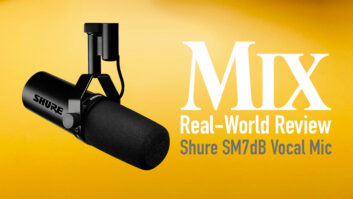Like many small diaphragm condensers (SDCs), there’s not much to describe about the new Hummingbird from Blue. It’s a small cylindrical body with a small diaphragm capsule (based on Blue’s popular Bottle B1), no switched filters or pads and no-IC Class A electronics. Yet the capsule pivots 180 degrees!
We are creatures of convenience: you were likely intrigued at the thought of quickly rough-positioning mics and then easily fine-adjusting its heads at your source. And you should be, as this one small innovation is quite useful, especially for self-recordists, phase coherence experts, and those miking drums and percussion.
Hummingbirds are pressure gradient condensers with a cardioid pickup pattern, full bandwidth response up to 20 kHz, one kilo-ohm load, and are quite sensitive with only 8.5 dB of A-weighted self-noise (quite good for an SDC, which are comparably noisy). Each Hummingbird is 6.7-inches long (a little longer than many SDCs). Here are full details, courtesy of Blue: http://www.bluemic.com/hummingbird/.
I’m normally a traditional Sennheiser MD 421 kind of guy on toms, but these swiveling heads make for some super-easy mic placement. The sound is very crisp on toms—quick, with notable attack and generally exciting. Even if off-axis, cymbals were a good bit more rude than with dynamic mics. Drum room, snare (the swiveling head is so useful on this app), overheads, hat and ride were all suitable for the Hummingbird, with lots of detail (sometimes slightly more than you many need) and no SPL problems (padding the preamp may be necessary) with a fine overall balance and little hype way up high (10-12 kHz). Check out my audio example here: https://soundcloud.com/pro-audio-review-magazine/blue-hummingbirds-drum-rooms.
On vocals, the Hummingbird provided a really nice bottom end and detailed imaging yet needed a little top roll-off, to my tastes. This balance really suited acoustic instruments. Using a pair, one Hummingbird on a guitar’s body and the other aimed at the neck/body joint provided a nicely articulated guitar sound with very little EQ, although I required a ribbon mic to add some chesty bottom-end to this B-Grade guitar model. Example: https://soundcloud.com/pro-audio-review-magazine/blue-hummingbirds-guitars.
My most preferred application for the Hummingbird is in Foley work. The bottom end is complete without unrealistic hype; the mids have the requisite transient accuracy; and the top-end pulls out lifelike detail, imaging and action. Its low self-noise, pop filter and rotatable caps sure don’t hurt, either.
To summarize, the Hummingbird sounds fantastic and feels expensive, though it’s only $299 each, street. With its super convenient swiveling head, I’d guarantee it’s a solid choice for drums, instruments, Foley and “tapers” (music fans who record live music with a stereo pair and a portable recorder, often in ORTF, see photo).
Blue Microphones
http://www.bluemic.com/hummingbird/
Second Opinion: Blue Hummingbird
As a long-time fan of Blue microphones, I’ve long awaited the release of the company’s next studio-grade quality microphone. Over the past few years, in addition to entering the headphone market with one of the finest performing headphones to date, Blue has led the industry in “iDevice” recording accessories. Unfortunately there haven’t been any Blue studio microphones introduced for quite some time, so the Hummingbird is welcomed.
I’ve been testing a pair of Hummingbirds for several weeks and I absolutely love them. While it’s no surprise they do a wonderful job capturing drum overheads and acoustic guitar, I found they work equally well on electric guitar and harmonica and the rotating head allows the mic to be easily placed in positions not possible with fixed position microphones.
I’m not typically a fan of small diaphragm microphones on vocals, but I opted to give the Hummingbird a try while recording Brian Redahan’s voice on a recent project. I’ve recorded Brian a lot; he has one of the best rock voices that I’ve encountered. I typically use a Shure SM-7B or AEA A440 to capture his huge, larger-than-life, raspy tone as both mics are both perfectly suited for his vocal sound. Skeptical at first, I was astounded at the way the Hummingbird captured his vocal. On Brian’s voice, the Hummingbird has all of the rich, thick bottom and midrange of the A440 and all of the presence of the SM7B with an added sparkle on top.
Able to do an amazing job recording virtually any sound source, the Blue Hummingbird is the most versatile microphone I’ve encountered in a long time. —Russ Long
